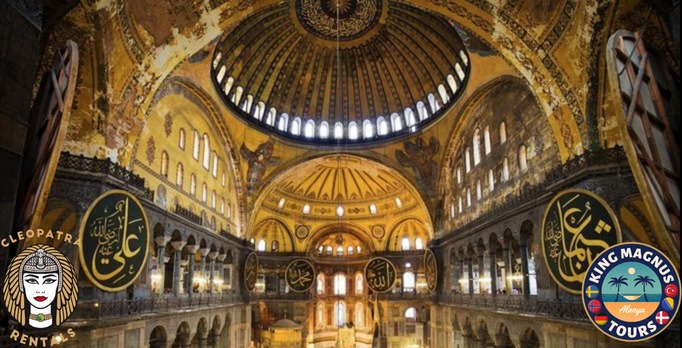Hagia Sophia, or Ayasofya in Turkish, is one of the most iconic landmarks in Istanbul and a symbol of the city’s rich and diverse history. Located in the Sultanahmet district, this architectural marvel has served as a cathedral, mosque, and museum over its long history. Today, it stands as a functioning mosque and a testament to the artistic and cultural heritage of the Byzantine and Ottoman empires.
Getting There
Hagia Sophia is situated at the heart of Istanbul’s historic Sultanahmet area, close to other major attractions such as the Blue Mosque and Topkapi Palace. Visitors can reach it easily by taking the tram to Sultanahmet station or by bus or taxi. Admission is free, but visitors are advised to check prayer schedules as it operates as an active mosque.
A Historical and Architectural Marvel
Originally constructed in 537 AD during the reign of Byzantine Emperor Justinian I, Hagia Sophia was designed to be the largest cathedral in the world. Its massive dome, measuring 31 meters in diameter, was an engineering marvel of its time. For nearly a thousand years, it stood as the largest Christian church in the world before being converted into a mosque in 1453 following the Ottoman conquest of Constantinople.
The mosque underwent various modifications under Ottoman rule, including the addition of minarets, a mihrab, and Islamic calligraphy. In 1935, it was transformed into a museum, showcasing its unique blend of Byzantine and Islamic art. In 2020, Hagia Sophia was reconverted into a mosque, continuing its legacy as a place of worship and cultural significance.
What to Explore
-
The Great Dome: The awe-inspiring dome appears to float above the building, thanks to a series of hidden supports. Its intricate mosaics and engineering brilliance leave visitors speechless.
-
Byzantine Mosaics: Despite its conversion into a mosque, many of the original mosaics, depicting Christian figures and scenes, have been preserved and are visible to visitors.
-
The Minarets: The four minarets added during the Ottoman era blend seamlessly with the Byzantine architecture, symbolizing the fusion of cultures.
-
The Calligraphy Panels: Large wooden medallions inscribed with Arabic calligraphy decorate the interior, highlighting the building’s Islamic heritage.
-
The Omphalion: This marble section of the floor is said to be where Byzantine emperors were crowned, adding a touch of historical intrigue.
-
The Upper Gallery: Visitors can climb to the upper levels for a closer look at the mosaics and stunning views of the interior.
Tips for Visitors
-
Respect the Atmosphere: As Hagia Sophia is an active mosque, visitors should dress modestly and observe quiet decorum. Scarves are provided at the entrance if needed.
-
Avoid Peak Hours: Early mornings or late afternoons are the best times to visit to avoid large crowds.
-
Photography: Photography is allowed, but using flash or drones requires special permissions.
-
Accessibility: Be prepared for some steps and uneven surfaces, particularly in the upper gallery.
Conclusion
Hagia Sophia is not just a building; it is a story of resilience, transformation, and coexistence. Its breathtaking architecture and rich history make it a must-visit landmark for anyone traveling to Istanbul. Whether marveling at its immense dome, exploring its intricate mosaics, or simply soaking in its serene atmosphere, a visit to Hagia Sophia is a journey through the ages and a celebration of Istanbul’s unique heritage.
?



